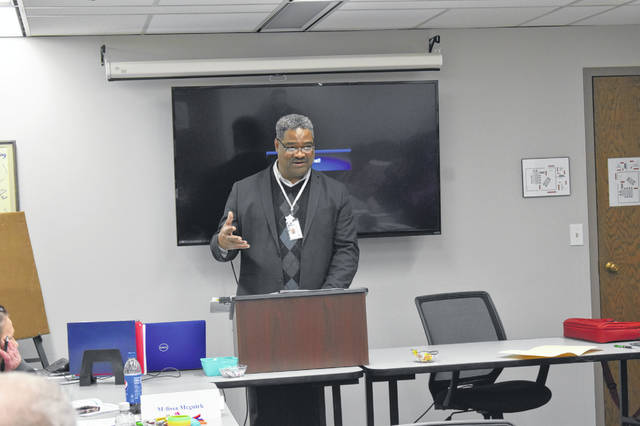
Specialists from the Delaware General Health District gave a briefing about Project Dawn and explained how and when to use Naloxone last week during the Delaware-Morrow Mental Health & Recovery Services Board’s peer recovery training.
The training was led by three health district employees — Kelly Fernandez, an emergency preparedness specialist; Emily Patterson, an epidemiologist; and Korin Reed, a public health nurse — as well as Ben McDay, who oversees the Families in Recovery Program at Maryhaven in Delaware.
The attendees of the training were briefed on Project Dawn, which stands for Deaths Avoided With Naloxone, and were given instructions on how to spot an overdose and administer the drug, also known as Narcan.
The health district explained that Naloxone works by blocking the opioid receptors in the brain and reverses the effects of opioids.
According to the presentation, the symptoms of an overdose include pinpoint pupils; a limp, slow pulse; irregular breathing; the person being non-responsive; blue tinged skin on the lips and fingertips; and choking or gurgling/snoring sounds.
The health district then instructed the trainees on what to do in response to an overdose.
The first step is to assess the person and try to stimulate the person and do a sternum rub. The next step is to call 911 and then begin rescue breathing. The process for rescue breathing was explained as getting the subject on their back, lifting their chin, removing any objects in their mouth, pinching their nose and giving two breaths (enough to see the chest rise).
At this point, the trainees were instructed on how to administer Narcan by inserting the nasal spray nozzle into either nostril and firmly pressing the plunger in order to release the dose.
The health district said after administering Narcan, it’s crucial to monitor and support the person, and if the victim is still not responsive and breathing on their own, continue to provide rescue breathing — one breath every five seconds. After two minutes with no response, administer second dose of naloxone, and if they remain unresponsive, continue to provide rescue breathing until EMS arrives.
Officials explained that it’s important for the first aid giver to remain as calm as possible and make sure they are remaining safe.
“It’s going to be an intense moment,” Fernandez said, adding the first aid giver should not disregard signs or symptoms of stress or trauma after the situation.
The health district also discussed Ohio’s Good Samaritan Law, which grants criminal immunity from minor drug possession charges to the victim and the person who administered Naloxone if they seek medical help. The health district said immunity only applies if you seek medical help. Officials added first aid providers are protected from liability if they are trained, administered Naloxone, and called 911.
At the conclusion of the training, the trainees were given their own Naloxone kit and were certified.
“This is a harm reduction program, we are trying to save a life,” Fernandez said. “You may hear it as a controversial issue, but at the end of the day, it’s harm reduction.”
McDay said the program is saving people who are addicted, even if they don’t want help. He added it’s important not to give up on people.
“This is about life and saving lives,” McDay said. “It’s about helping people, even if they don’t want help sometimes. You bring that help and keep people alive until they can want it. I don’t go along with the idea that ‘you keep using, just forget you’ and walk away and let you die … that’s not human.”
McDay said trainings like the ones held in Delaware last week are very important to combating the opioid epidemic.
“It’s a tremendous benefit to the community,” he said. “People just don’t know, that’s the thing. They try and find knowledge, and if they get the wrong knowledge, they could mess up. If you have paid professionals teaching people what to do in crisis situations, the whole community benefits from that. This disease is effecting the whole county.”
McDay said Maryhaven runs a similar program called the Families in Recovery Program, that provides education, training, and counseling support to families who are dealing with substance abuse problems.
McDay said that program is also funded by the board and is free to anyone in Delaware and Morrow counties.
“There are a lot of families sitting in their homes right now who want to get help,” McDay said. “There’s some stigma to it, but when it boils down to it, they need to reach out to get the help they need so that they don’t contribute to the problem.”
For more information about the Families in Recovery Program, contact McDay at 740-203-3800 or [email protected].


